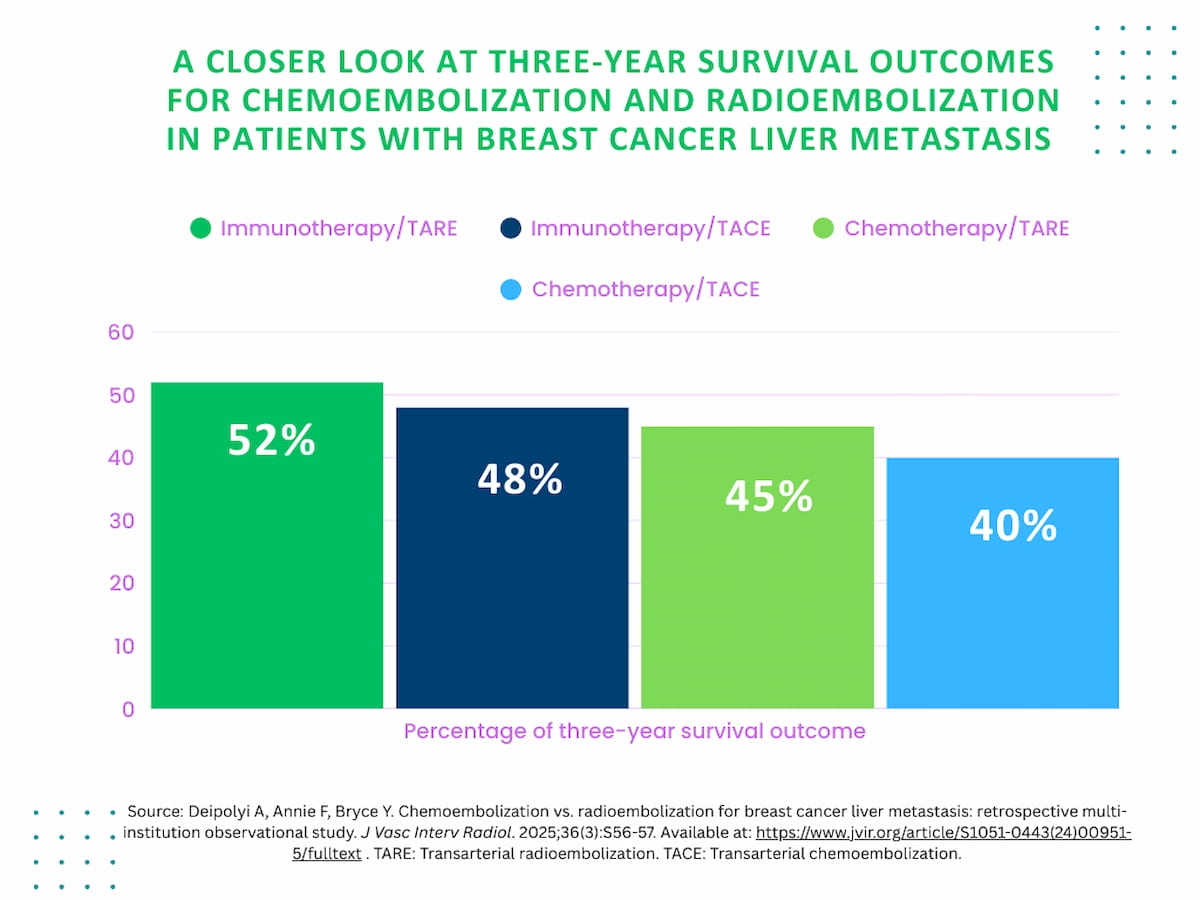What New Interventional Radiology Research Reveals About Treatment for Breast Cancer Liver Metastases
Emerging research from the recent Society of Interventional Radiology (SIR) conference suggests the combination of transarterial radioembolization (TARE) and immunotherapy may offer improved three-year survival outcomes for patients with breast cancer and liver metastases.
For patients with breast cancer liver metastases, the combination of immunotherapy and transarterial radioembolization (TARE) may significantly enhance survival outcomes over other treatment options, according to new research presented at the recent Society of Interventional Radiology (SIR) conference.
In a recent interview, lead study author Amy Deipolyi, M.D., pointed out that approximately one-fifth of breast cancer deaths are due to liver metastasis. In her experience with subspecializing in the treatment of patients with breast cancer, Dr. Deipolyi has found that half of these patients will develop metastatic breast cancer with the metastasis frequently occurring in the liver.
In light of these sobering trends, Dr. Deipolyi and her colleagues sought to compare TARE/immunotherapy to transarterial chemoembolization (TACE)/immunotherapy, TARE/chemotherapy, and TACE/chemotherapy in a total cohort of 418 patients with breast cancer and liver metastases.
In an interventional radiology study involving 418 patients with breast cancer liver metastases, TARE/immunotherapy offered the highest three-year survival rate in comparison to TACE/immunotherapy, TARE/chemotherapy and TACE/chemotherapy.

The study authors found that TARE/immunotherapy offered the highest median overall survival (38 months) and the highest three-year survival rate at 52 percent in comparison to 48 percent for TACE/immunotherapy, 45 percent for TARE/chemotherapy and 40 percent for TACE/chemotherapy.
Dr. Deipolyi said these multicenter comparative study findings align with previous single-center retrospective work comparing Y-90 radioembolization and chemoembolization in the treatment of breast cancer liver metastases.
“The overall impression you get is that Y-90 (radioembolization) yields better imaging results, more objective responses, and is better tolerated with fewer side effects,” posited Dr. Deipolyi, the chief of interventional radiology at the Charleston Area Medical Center in Charleston, W.V., and associate professor at West Virginia University.
Lending further credence to the comparative study findings presented at the SIR conference was the fact that the cohort was drawn from a query of 68 health-care organizations via the federated TriNetX database, which allows real-time access to research data collection from a network of 145 hospital organizations, according to study co-author Frank Annie, Ph.D., a clinical research manager and assistant professor in the Department of Cardiology at the Charleston Area Medical Center in Charleston, W.V.
(Editor’s note: For related content, see “Interventional Radiology Study Shows Low Breast Cancer Recurrence 16 Months After Cryoablation,” “Current Perspectives on PET/CT Imaging in Patients with Metastatic Breast Cancer” and “Systematic Review: PET/MRI May be More Advantageous than PET/CT in Cancer Imaging.”)
For more insights from Drs. Deipolyi and Annie, watch the video below.
Reference
1. Deipolyi A, Annie F, Bryce Y. Chemoembolization vs. radioembolization for breast cancer liver metastasis: retrospective multi-institution observational study. J Vasc Interv Radiol. 2025;36(3):S56-57. Available at: https://www.jvir.org/article/S1051-0443(24)00951-5/fulltext .
CT Perfusion Study Shows Enhanced Detection of Medium Vessel Occlusions with Emerging AI Software
May 21st 2025The Rapid CTP AI software offered 23 percent greater detection of medium vessel occlusions in comparison to the Viz CTP AI software, according to research presented at the European Stroke (Organization) Conference (ESOC).
Can AI Predict Future Lung Cancer Risk from a Single CT Scan?
May 19th 2025In never-smokers, deep learning assessment of single baseline low-dose computed tomography (CT) scans demonstrated a 79 percent AUC for predicting lung cancer up to six years later, according to new research presented today at the American Thoracic Society (ATS) 2025 International Conference.
Mammography Study Compares False Positives Between AI and Radiologists in DBT Screening
May 8th 2025For DBT breast cancer screening, 47 percent of radiologist-only flagged false positives involved mass presentations whereas 40 percent of AI-only flagged false positive cases involved benign calcifications, according to research presented at the recent American Roentgen Ray Society (ARRS) conference.
MRI Study at ARRS Raises Questions About Disparities in Detection of MASLD
May 3rd 2025New research revealed that Hispanic Americans with evidence of hepatic steatosis on MRI but no formal diagnosis of MASLD had over a fourfold higher risk of developing hepatocellular carcinoma in comparison to those who had a formal diagnosis of MASLD.
FDA Clears MRI-Based AI Segmentation of Organs at Risk During Radiation Therapy
May 2nd 2025Capable of segmenting over 37 organs and structures in the head, neck and pelvis, the MR Contour DL software is currently being showcased at the European Society for Radiotherapy and Oncology (ESTRO) conference.